Milestone Memoir: Handout and Examples
As I mentioned in the Introductory Post, Milestone Memoir is my vision of marrying one picture (worth 1,000 words) with one personal essay (500-1,500 words) to create a meaningful narrative for future generations.
This method varies from traditional scrapbooking in that it places more emphasis on the written word, and less attention on decorative elements. While journaling is always encouraged, many scrapbookers treat writing as an after-thought. We try to ensure that the 5Ws are addressed (who, what, where, when, and why), but we tend to focus more on the layout’s visual appeal.
Please note that I do not see Milestone Memoir as a replacement for current scrapbook techniques. Instead, I see it as coming along-side your other photo preservation methods. It is more of a hybrid of scrapbooking and storytelling – YOUR story that needs to be shared with others.
Over these past few weeks, I have unveiled the nine-step process: Step 1: Brainstorm a Theme; Steps 2 and 3: Brainstorm Chapters and Review Photos; Step 4: Select ONE photo per chapter; Step 5: Page Layouts and Color Schemes. Today will serve as a recap.
* * * * *
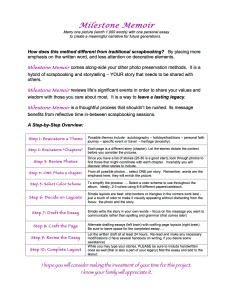 At this point in the process, the scrapbooking decisions are made and all that’s left is drafting and finalizing the story. I will share a few tips for writing a personal essay next week, but for now I thought it might be helpful to share a handout that summarizes the steps of Milestone Memoir.
At this point in the process, the scrapbooking decisions are made and all that’s left is drafting and finalizing the story. I will share a few tips for writing a personal essay next week, but for now I thought it might be helpful to share a handout that summarizes the steps of Milestone Memoir.
I previewed this concept at my crop a couple of weeks ago, and I hope to hone the wording over the next few months. At that point, I will (hopefully) begin teaching classes.
The crop was my first scrapbooking event since 2007, and it felt good to return “home”. I enjoyed the fellowship with old friends and gladly welcomed new scrapbookers into the fold. I plan to hold a crop-a-month in my home to encourage others to complete their projects and to inspire me to work on my own.
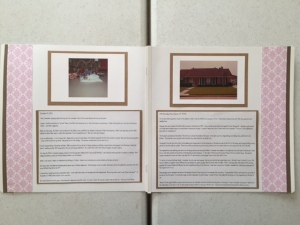 Because I spent time in advance of the crop brainstorming a theme, outlining possible chapters, reviewing photos (and narrowing to just one per chapter), printing the pictures, and selecting a color scheme …. I managed to complete two chapters: one details my life as a December birthday, and the other reminisces my first home and neighborhood.
Because I spent time in advance of the crop brainstorming a theme, outlining possible chapters, reviewing photos (and narrowing to just one per chapter), printing the pictures, and selecting a color scheme …. I managed to complete two chapters: one details my life as a December birthday, and the other reminisces my first home and neighborhood.
I have about sixty-four more photos and corresponding stories to write, but I do not find this overwhelming. I have a notebook where I keep notes for each chapter, and I am continually reviewing the timeline to see if there is another story I want to include. I draft the essays on the computer, using the notes to help with structure. These two essays are approximately 350-550 words, and I wrote each in about thirty minutes.
I want to reiterate, however, this is not a scrapbook to complete in haste. It benefits from reflection and thoughtful consideration of Milestone moments worthy of inclusion. It is a project that can be completed while working on other albums that perhaps use more right-brain creativity.
I have set the goal of writing two essays per week with the hope of completing this first Memoir by the end of June. It is my plan to periodically post completed layouts and perhaps participate in Throwback Thursdays with nostalgic photographs.
While this is not the writing life I envisioned a year ago…. it is the perfect writing life for me at this point in time.
Milestone Memoir: Step 5
As I mentioned in the Introductory Post, Milestone Memoir is my vision of marrying one picture (worth 1,000 words) with one personal essay (500-1,500 words) to create a meaningful narrative for future generations.
This method varies from traditional scrapbooking in that it places more emphasis on the written word, and less attention on decorative elements. While journaling is always encouraged, many scrapbookers treat writing as an after-thought. We try to ensure that the 5Ws are addressed (who, what, where, when, and why), but we tend to focus more on the layout’s visual appeal.
Please note that I do not see Milestone Memoir as a replacement for current scrapbook techniques. Instead, I see it as coming along-side your other photo preservation methods. It is more of a hybrid of scrapbooking and storytelling – YOUR story that needs to be shared with others.
Over these past few weeks, I have unveiled the nine-step process: Step 1: Brainstorm a Theme; Steps 2 and 3: Brainstorm Chapters and Review Photos; Step 4: Select ONE photo per chapter. Today we will focus on Step 5: Page Layouts and Color Schemes
* * * * *
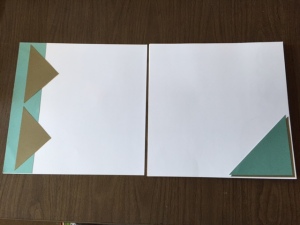 In traditional scrapbooking, we tend to look at the photos, consider the event, and then design a page around those elements. This method often places the layout as the focus (the paper, stickers and other embellishments) and the story becomes secondary. This is a fun, creative way to showcase photos and utilize artistic talent.
In traditional scrapbooking, we tend to look at the photos, consider the event, and then design a page around those elements. This method often places the layout as the focus (the paper, stickers and other embellishments) and the story becomes secondary. This is a fun, creative way to showcase photos and utilize artistic talent.
Milestone Memoir, however, puts the story front and center. It is the single photograph and the accompanying words that take priority. However, a touch of decoration adds visual appeal and should not be ignored.
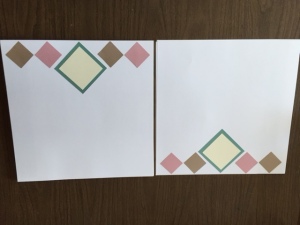 I believe that simple is best, but simple does not mean boring.
I believe that simple is best, but simple does not mean boring.
When I was a Creative Memories consultant several years ago, we had a series of idea books called “Fast Formulas” These were invaluable to me as a consultant as well as a scrapbook enthusiast. Over the past few years, however, I have learned that we can all design our own “fast formulas” by analyzing layouts we enjoy.
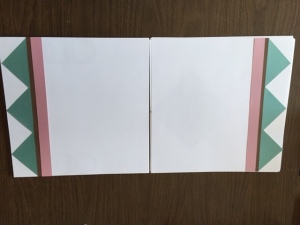 I encourage you to look at idea books, scrapbook magazines, and Pinterest. When you find a page you like, stop and analyze the elements of the design: is it the way the photos are grouped together – the decorative corner design – or the unique borders along the outside edge? Use these pages as models for your own “fast formula” collection.
I encourage you to look at idea books, scrapbook magazines, and Pinterest. When you find a page you like, stop and analyze the elements of the design: is it the way the photos are grouped together – the decorative corner design – or the unique borders along the outside edge? Use these pages as models for your own “fast formula” collection.
Once you have collected 15-20 different page layouts, you have more than enough ideas for a completed album.
The next step is to devise a color scheme. I love this idea for two reasons:
- It limits the decision process. Once you have pre-selected 3-4 colors and/or 6-8 papers to use throughout the album, layouts are a breeze.
- It provides consistency. The theme for the album may be subtle, but a consistent color scheme will reinforce that common thread.
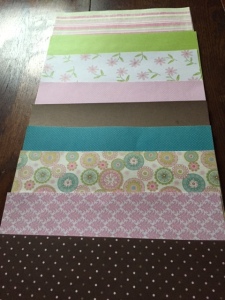 For my first Milestone Memoir (autobiography from birth to marriage), I considered the photos as well as my color preference. In the end, I decided to use soft browns, mauve pinks, moss greens, and the occasional turquoise. I chose papers that I liked because…. well… this is MY album, MY story and I want to use colors that bring me joy.
For my first Milestone Memoir (autobiography from birth to marriage), I considered the photos as well as my color preference. In the end, I decided to use soft browns, mauve pinks, moss greens, and the occasional turquoise. I chose papers that I liked because…. well… this is MY album, MY story and I want to use colors that bring me joy.
You can either decorate pages ahead of time and then add photos and essay later… or you can decide which design to use based on the particular photo. While the former makes for efficiency… I tend to prefer the latter.
At this point, you are ready to create!
Next week I will preview a Milestone Memoir handout. I will also showcase a few sample pages from my “Milestone Memoir” before I delve into drafting the essay.
Milestone Memoirs: Step 4
As I mentioned in the Introductory Post, Milestone Memoir is my vision of marrying one picture (worth 1,000 words) with one personal essay (500-1,500 words) to create a meaningful narrative for future generations.
This method varies from traditional scrapbooking in that it places more emphasis on the written word, and less attention on decorative elements. While journaling is always encouraged, many scrapbookers treat writing as an after-thought. We try to ensure that the 5Ws are addressed (who, what, where, when, and why), but we tend to focus more on the layout’s visual appeal.
Please note that I do not see Milestone Memoir as a replacement for current scrapbook techniques. Instead, I see it as coming along-side your other photo preservation methods. It is more of a hybrid of scrapbooking and storytelling – YOUR story that needs to be shared with others.
Over the next several weeks, I will continue to outline the nine-step process. Step 1 was to Brainstorm a Theme; steps 2 and 3 were to Brainstorm Chapters and Find Corresponding Photos.
* * * * *
Step 4: Narrow Photos to ONE per chapter
This might seem a reasonable request for some; for others, palms may start to sweat with shortness of breath to soon follow. How can I pick just one?!
For us old-timers, that is… pre-digital photography, we had to pay for every picture taken. This caused us to be more selective in shooting habits. For example, while I might have devoted an entire roll of film to a specific event, let’s say a birthday party, that meant I only took 24 pictures (36 if I was feeling particularly wealthy). Since I am an amateur photographer at best, several of those images would be considered substandard: too blurry, finger in the frame, too far away to discern the subject matter. So typically I might have 8-10 usable images; narrowing the choice to just one is not too daunting.
But how do I choose?
There are, of course, the iconic birthday shots such as the pile of gifts, blowing out the candles, and eating the cake. But what if I had to select one image to represent the entire event, would an iconic image be best? Perhaps a photograph capturing a unique expression would tell more of the story.
There is of course no right answer, it is your perspective – your story. But selecting one photo with layered meaning begs the viewer to read the words rather than simply assume the photo’s significance. In this way, the photograph enhances the words… and vice versa. It is a relationship where the sum of the whole is greater than each of its parts.
In this digital age, however, narrowing the selection can be more difficult. Because there is no cost associated with taking pictures (only in making prints), we snap hundreds of photos at a time. We of course delete the imperfect images, but we are still left with far more usable shots that make the selection of just one seem impossible.
Please don’t misunderstand me. I am not advocating Milestone Memoir should replace the family scrapbook. We all love looking at photos – remembering the various people and reminiscing about the event. Decorative pages incorporating several pictures are encouraged in this format. Typically we try to complete those scrapbooks as soon after the event as possible, while details are still fresh in our minds.
But Milestone Memoir emphasizes the story behind the photograph. Often, it helps if some time has passed: distance from the event allows us to hone a perspective and discern meaning and signficance. What do I remember most about that event? What message do I want to communicate to future generations that could be summed up in just one image?
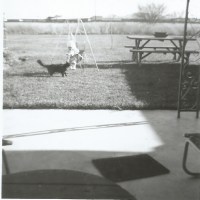
Me with Mindy – there are two stories within this photo, even though you can hardly discern the characters or setting.
And here is one more idea and then I will close.
Sometimes “the one” photo is NOT technically the best. Sometimes “the one” is slightly out-of-focus, or overexposed, but the story behind the imperfect picture is begging to be shared.
Don’t silence the story. Allow the words to enrich the photograph. In the end the audience will not criticize the image but instead connect with the message.
Next week I will discuss Step 5: Page Layouts and Color Scheme
Sunday Salon: January 4, 2015
I took an unintentional blog break over the holidays, and while it is easy for me to feel guilty for not maintaining this writing routine, I will instead give myself grace and embrace this new year with new resolve to be more intentional about life.
Reading: I managed to achieve my 2014 reading goal of completing 52 books, and have decided to set that goal again for this year.
In reviewing my Goodreads list, however, I notice that it is severely lacking in novels and way too heavy in non-fiction books related to writing, self-improvement, and spiritual matters. It is my goal to maintain a more balanced reading life in 2015.
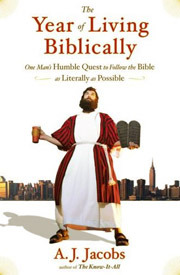 I am currently reading The Year of Living Biblically by A. J. Jacobs, and I must confess it is not exactly what I expected, but it is a satisfactory read. His sense of humor coupled with his academic investigation makes what could be a dry subject rather enjoyable.
I am currently reading The Year of Living Biblically by A. J. Jacobs, and I must confess it is not exactly what I expected, but it is a satisfactory read. His sense of humor coupled with his academic investigation makes what could be a dry subject rather enjoyable.
Ultimately I have learned that it is exhausting (not to mention impossible) to maintain the hundreds of laws found in the Old Testament. This in turn has led me to a greater appreciation for the Redemptive love of Christ who came to earth so we no longer have to struggle to follow all those rules.
I am currently searching for my first novel of the year to read. While there are many classics that are vying for my attention, I think I should start this new practice with something modern and perhaps a bit easier to escape into the fiction world. Do you have any possible suggestions?
Writing: I have intentionally scaled back my writing endeavors. The NaNoWriMo novel, First Impressionism, is on the back burner for now. Perhaps this summer during Camp NaNo I will be ready to revise.
Investigating possible publishing avenues has also taken a backseat for now. I continue to struggle finding a subject of interest and as a result, all writing efforts seem forced, as if I am playing pretend. I am certain I will return to writing with a renewed passion, but for now, I am going to focus my efforts on Milestone Memoir.
I currently have all the pictures printed (about 50) and story ideas outlined (about 35) for my first Milestone Memoir album. I have a total of five album projects waiting in the wings, and I am anxious to get started.
I have scheduled my first Creative Memories crop for this Friday and have eight ladies coming to my house to scrapbook. I am thrilled! My last official crop was June 2007, and I feel as though I am returning home after an extended journey. It is my hope to offer one crop a month to give others an opportunity to work on their albums as I continue to work on mine.
Blogging: I thoroughly enjoyed working on the 31 Days of Christmas Joy, even though it resulted in only fourteen posts. One of my New Year’s goals is to practice photography more – and with that practice I hope to share more posts on that blog.
I will also return to regular Wednesday posts here, talking mostly about writing and scrapbooking, but perhaps throwing in a few book reviews and other personal interests. Sunday Salon posts are my staple, as I always look forward to connecting with other readers and sharing our week’s successes and struggles.
I have two trips planned the first quarter of 2015 and with that, I hope to resurrect my travel blog once again. I still harbor dreams of creating several Milestone Memoirs centered on my travels around the country and around the world… and I hope to begin working towards making that dream a reality this year.
Word of the Year: DELIGHT
As I shared a couple of weeks ago, I love the layered meaning of this word. I love how DELIGHT means extreme joy – and I have wanted to focus on finding joy in the moment for several years now.
I love how “light” can refer to weightlessness – learning to let go of things that hold me down and adopting a more carefree lifestyle. I need to balance my need for productivity with a need for play – doing what I enjoy doing simply because it brings me pleasure.
And I love that the word brings to mind the metaphor that Jesus is the Light of the world. By focusing on my word of the year, I am also focusing on my savior.
The scripture verse for this year is found in Psalms 37:4
Take delight in the Lord, and He will give you the desires of your heart.
I am looking forward to a fantastic 2015 – and I wish the same for all of you.
Milestone Memoir: Steps 2 and 3
Steps 2 and 3: Brainstorm “Chapters” and Find Photos
As I mentioned in the Introductory Post, Milestone Memoir is my vision of marrying one picture (worth 1,000 words) with one personal essay (500-1,500 words) to create a meaningful narrative for future generations.
This method varies from traditional scrapbooking in that it places more emphasis on the written word, and less attention on decorative elements. While journaling is always encouraged, many scrapbookers treat writing as an after-thought. We try to ensure that the 5Ws are addressed (who, what, where, when, and why), but we tend to focus more on the layout’s visual appeal.
Please note that I do not see Milestone Memoir as a replacement for current scrapbook techniques. Instead, I see it as coming along-side your other photo preservation methods. It is more of a hybrid of scrapbooking and storytelling – YOUR story that needs to be shared with others.
Over the next several weeks, I will continue to outline the nine-step process. Last week we brainstormed a theme for our album. This week we will brainstorm possible chapters and locate coordinating photos.
* * * * *
Writers are often categorized as either Plotters (those who give considerable thought to plot, characters, and structure prior to writing a single word) and Pantsers (those who jump right into writing without much forethought. “Flying by the seat of your pants” if you will). As you can deduce from this overview, I am a Plotter. I like to know where I am going before I begin a journey.
It isn’t that you can’t begin this project right away, starting whenever and wherever the mood strikes, but for those who need a bit more structure, I will detail my typical process.
Since I learn best by example, I will use my Milestone Memoir projects to illustrate the process.
In brainstorming possible themes, I narrowed the focus to three separate albums. I want to document our Holiday Traditions (focusing on Christmas, but including other annual celebrations as well), my parents’ stories (as best I know), and my memoir.
Upon further reflection, I decided that my memoir could be divided into two books: Before children and After children. I reason that life Before Children is purely “my” memoir – it is the story of my childhood and (hopefully) an explanation of who I am and why. The story after children will be more my perspective on the life that others have witnessed from their point-of-view.
My first “Milestone Memoir” will be my story before children.
Now I am a concrete sequential thinker, which means, I like structure and order. For me, the ideal structure for this particular album will be chronological. I will start with birth (as best I can) and end with married life, working and living in New York City.
Since I want this to be my memories, I will start brainstorming key events I wish to record. I could look through photos first, selecting the picture and then writing the story to match … but I feel that may be too limiting. Our family did not take many pictures, and I want to be sure to include all pertinent stories.
For example… I am not fond of doctors. Some would be appalled to learn that I had my first physical sixteen years after the birth of my last child – or that I refuse to have a mammogram. However… this avoidance has to do with the fact that was on a constant dose of antibiotics from the ages of two to five; or that I had to take five pills a day for two years because my tuberculosis test proved positive; or that my confidence was betrayed by my doctor when I was in high school.
While these reasons are not meant to be excuses for my neuroses, hopefully they offer a plausible explanation.
However, we have no pictures of my childhood doctor – or my tonsillectomy hospitalization – or my pill bottle. Instead, I can only find an ordinary photograph of that time in my life when I look “pale and sickly” – this is an opportunity to use an unimpressive picture to tell a particular story.
Does this make sense? If I had reviewed photos first without giving thought to the memories I want to preserve, I would have missed this valuable story.
Once I have a list of possible chapters (which can change over time), I will then begin the process of reviewing old family photos. I will warn you… this process can be a bit slow and tedious, but it is worth the effort! If pictures are unorganized, be prepared to look at each one and attempt to file in a usable format for future reference.
But also, don’t miss the joy in this process. Recall past memories (you may discover new chapters for the album), and relish the nostalgia of your lifetime.
Once I have found usable photos, I will then scan them. This not only provides a digital copy for future generations, but it also gives me the opportunity to edit them for a better printed image.
At this point, I have matched stories with photos and have a good workable outline for the book. I am well on my way to creating a memorable Milestone Memoir.
Next week I will discuss Step 4: Narrow photos to ONE per chapter




